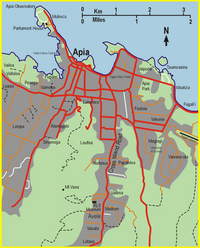Apia, Samoa
|
|
Apia, population 38,800 (2001), is the capital of Samoa. The city is located on the northern coast of Upolu Island. It is the nation's major port and only city. Fish, and copra are the country's major exports, and cotton goods, motor vehicles, meats, and sugar are the major imports.
| Contents |
Location
Apia (Template:Coor dm) is situated on a natural harbour at the mouth of the Vaisigano river. It is on a narrow coastal plain with Mt. Vaea (Elev. 472 m) directly to its south. Two main ridges run south on either side of the Vaisigano river with roads on each. The more western of these is Cross Island Road which is one of the few roads crossing to the south coast of Upolu.
City features
Samoa_-_Apia_Govt_buildings.jpg
Mulinu'u, the old ceremonial capital, lies at the city's western end and is the location of the Parliament House (Fale Fono) as well as the historic observatory which is now the meteorology office.
An area of reclaimed land jutting into the harbour is the site of the multistorey Government Offices and the Central Bank of Samoa. In the centre of the city is a clock tower erected as a war memorial. Apia has a number of multistorey buildings of recent origin but there are still some of the early, wooden, colonial buildings scattered around the town, most notably the courthouse with the museum on the upper floor. After years of neglect, this building was restored in 2004.
Also on reclaimed land is the main bus station near the fish market and the old market which now sells handicrafts. The new market (maketi fou) is inland a bit at Fugalei where it is more protected from the effects of cyclones.
Writer Robert Louis Stevenson spent the last 4 years of his life here and is buried on Mt. Vaea overlooking both the city and the home he built, "Vailima", which is now a museum in his honour.
Transport
Apia harbour is by far the largest and busiest harbour in Samoa. International shipping with containers, LPG gas and fuels all dock here. Ferries to Tokelau and American Samoa depart from here. Apia is served by a good road network which is generally kept reasonably well maintained. Most of the main roads are sealed with the few unsealed roads having lower use. Vehicles drive on the right-hand side of the road. Speed limits are 25 mph near the centre of town and 35 mph in the rest of the country with a 15 mph limit in special circumstances. The country has no trains or trams but is served with an extensive bus service. It is common for people to walk around the town or even for some distances outside it. There are few bicycles and motorcycles. There are increasing numbers of privately owned cars. Taxis are a common form of transport. Apia has a small airstrip (Fagali'i) which is used for internal flights and some international flights to Pago Pago in American Samoa. The main international airport (Faleolo) is a 40 minute drive west of the city.
Housing
This is a mixture of old colonial houses and more modern western style houses interspersed with some traditional Samoan houses (fale).
bg:Апия de:Apia es:Apia gl:Apia he:אפיה (עיר) io:Apia ja:サモア nl:Apia pl:Apia ru:Апиа


